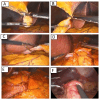Evaluation of Laparoscopic Sleeve Gastrectomy With a Natural Band (Sewefy Wrap): Results From a Prospective, Randomized Controlled Trial
- PMID: 40491645
- PMCID: PMC12146793
- DOI: 10.7759/cureus.83733
Evaluation of Laparoscopic Sleeve Gastrectomy With a Natural Band (Sewefy Wrap): Results From a Prospective, Randomized Controlled Trial
Abstract
Background Laparoscopic sleeve gastrectomy (LSG) is the most popular bariatric surgery procedure. Adding a synthetic band to LSG is reported to decrease the incidence of weight regain. However, the synthetic material has many drawbacks. This study aimed to evaluate the use of a natural flap as a band with LSG. Methods This study was a prospective, randomized controlled trial and included 80 patients with morbid obesity. It was conducted in the Minia University Hospital between November 2022 and February 2024. Participants were equally and randomly assigned to two groups. In one group, the patients underwent LSG and banding using either the Teres ligament (the round ligament of the liver) or a tight omental flap. In the second group, the standard LSG procedure was carried out without any band. Results The mean follow-up period was 13.5 months. At one year, the mean gastric volume was significantly less in the banded group (110.7 ml) than in the non-banded group (147.3 ml; p=0.000), and the mean % excess weight loss (EWL) was significantly higher in former (85.8%) than in the latter group (79.5; p=0.002). Similarly, the mean % total weight loss (TWL) was also significantly higher in the banded group (41.3%) than in the non-banded group (36.7%; p=0.010). Moreover, the mean score of food tolerance was 20.8 in the banded group versus 21.1 in the non-banded one (p=0.172). Conclusions LSG along with the a natural band using a nearby flap like the round ligament of the liver or an omental flap leads to better weight loss than non-banded LSG. It is also associated with minimal pouch dilatation and a low complication rate. The use of this technique is, hence, a promising procedure that minimizes sleeve pouch dilatation (the main cause of weight regain after LSG) without any extra cost or complications associated with a foreign body. However, long-term follow-up for this procedure is needed.
Keywords: banded gastric bypass; banded sleeve gastrectomy; complications of banded bariatric procedures; laparoscopic sleeve gastrectomy; omental flap; teres ligament flap; weight regain.
Copyright © 2025, Sewefy et al.
Conflict of interest statement
Human subjects: Consent for treatment and open access publication was obtained or waived by all participants in this study. Faculty of Medicine, Minia University Ethical Committee issued approval 1062/11/2022. The protocol was approved by our local ethical committee (Department of surgery, Faculty of medicine, Minia university ethical committee). . Animal subjects: All authors have confirmed that this study did not involve animal subjects or tissue. Conflicts of interest: In compliance with the ICMJE uniform disclosure form, all authors declare the following: Payment/services info: All authors have declared that no financial support was received from any organization for the submitted work. Financial relationships: All authors have declared that they have no financial relationships at present or within the previous three years with any organizations that might have an interest in the submitted work. Other relationships: All authors have declared that there are no other relationships or activities that could appear to have influenced the submitted work.
Figures




Similar articles
-
Two-Year Results of the Banded Versus Non-banded Re-sleeve Gastrectomy as a Secondary Weight Loss Procedure After the Failure of Primary Sleeve Gastrectomy: a Randomized Controlled Trial.Obes Surg. 2023 Jul;33(7):2049-2063. doi: 10.1007/s11695-023-06598-z. Epub 2023 May 9. Obes Surg. 2023. PMID: 37156932 Free PMC article. Clinical Trial.
-
Comparison of Sleeve Volume Between Banded and Non-banded Sleeve Gastrectomy: Midterm Effect on Weight and Food Tolerance-a Retrospective Study.Obes Surg. 2023 Feb;33(2):406-417. doi: 10.1007/s11695-022-06404-2. Epub 2022 Dec 12. Obes Surg. 2023. PMID: 36508154 Free PMC article.
-
Banded Sleeve Gastrectomy: Better Long-Term Results? A Long-Term Cohort Study Until 5 Years Follow-Up in Obese and Superobese Patients.Obes Surg. 2018 Sep;28(9):2687-2695. doi: 10.1007/s11695-018-3248-2. Obes Surg. 2018. PMID: 29671124 Free PMC article.
-
Banded Versus Non-banded Sleeve Gastrectomy: A Systematic Review and Meta-Analysis.Cureus. 2024 Jan 23;16(1):e52799. doi: 10.7759/cureus.52799. eCollection 2024 Jan. Cureus. 2024. PMID: 38389592 Free PMC article. Review.
-
Primary Banded Sleeve Gastrectomy: a Systematic Review.Obes Surg. 2019 Feb;29(2):698-704. doi: 10.1007/s11695-018-03626-1. Obes Surg. 2019. PMID: 30552547
References
-
- Does gastric dilatation limit the success of sleeve gastrectomy as a sole operation for morbid obesity? Langer FB, Bohdjalian A, Felberbauer FX, et al. Obes Surg. 2006;16:166–171. - PubMed
LinkOut - more resources
Full Text Sources
